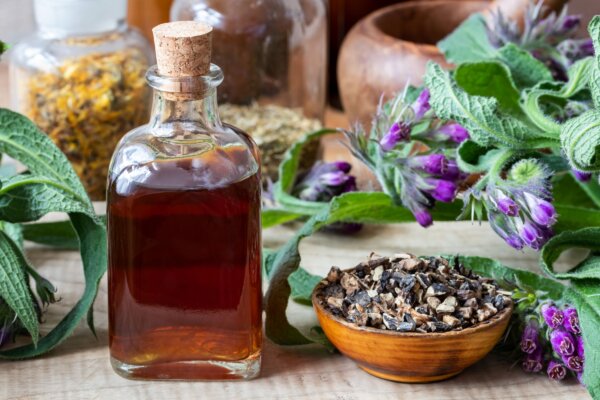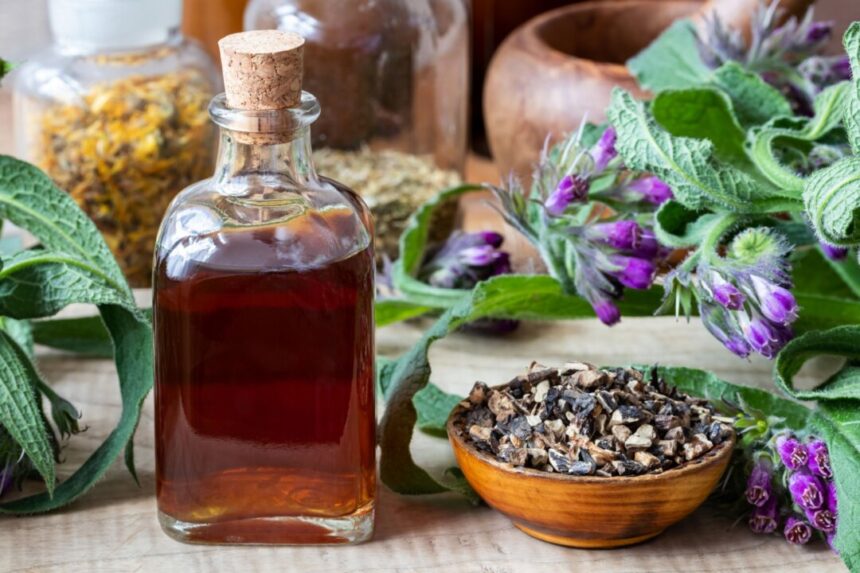
Known as “knit-bone,” comfrey has the extraordinary ability to stimulate the body to heal wounds quickly and mend tissues, bones, and cartilage.
When Molly Maples injured her little toe by slamming it into a door, she found that conventional medical advice was limited to icing, elevating, and using pain medication.
Unsatisfied with these options, Ms. Maples turned to traditional remedies, applying a comfrey and plantain weed poultice to her toe every night. “My toe healed completely in less than four weeks,” she told The Epoch Times.
In orthopedics, where precise treatments like bone setting and joint replacements are common, comfrey stands out as a time-honored alternative. Also known as “knit-bone,” this herb has been valued for generations for its ability to heal bones and relieve joint pain, demonstrating that nature still has a significant role to play in modern medicine.
Comfrey: Nature’s Bone Healer
Scientifically known as Symphytum officinale, comfrey has a long history in folk medicine, recognized for its healing properties since the Middle Ages in Europe and Asia. Comfrey has been widely used to reduce inflammation and speed up the healing of bruises, sprains, and fractures.
Amelia South, a trained herbalist and owner of Black Sun Farm, emphasized comfrey’s effectiveness in orthopedic care to The Epoch Times. “Comfrey is one of my top five herbs that I never want to be without. It has helped me heal a sprained ankle, sprained wrists, and numerous bruises,” Ms. South noted, praising its external application for significantly speeding up bone healing.
The herb also has various other medicinal uses. Comfrey has been used to treat respiratory conditions such as bronchitis, tonsillitis, and pneumonia by reducing inflammation and promoting lung moisture. Additionally, it is believed to support digestive health by aiding in blood sugar control and enhancing digestion through pepsin secretion.
Nancy Shirley, an author with publications on comfrey, extols the herb’s medicinal virtues. “Comfrey’s nickname, ‘knit bone,’ is highly appropriate as one of its constituents (allantoin) actually causes cellular proliferation,” she explained in an email to The Epoch Times. This compound stimulates the body to produce new cells rapidly, which is beneficial for healing wounds and mending tissues, bones, and cartilage.
The roots of comfrey are rich in phenolic acids such as rosmarinic, caffeic, and chlorogenic acids. These substances reduce inflammation and have potent antioxidant properties that protect cellular integrity and promote skin health.
Advanced extraction techniques, such as enzyme-ultrasonic assistance, have been used to isolate polysaccharides—complex sugars with anti-inflammatory properties—from comfrey, highlighting the plant’s role in modern therapeutic applications.
What Does the Research Say?
Research on comfrey’s effectiveness, especially in treating musculoskeletal conditions, shows promise. Various studies and clinical trials have evaluated its potential to heal sprains, bruises, and fractures.
Research published in the British Journal of Sports Medicine highlighted the effectiveness of comfrey root extract ointment for acute back pain. The trial, involving 120 patients, compared the effects of the ointment with a placebo, administered three times daily for five days. The reduction in pain intensity during movement was used to measure success.
The results showed a significant reduction in pain for the comfrey group—about 95 percent—compared to 38 percent in the placebo group. The researchers concluded that “Comfrey root extract showed a remarkably potent and clinically relevant effect in reducing acute back pain.”
A 2020 study in the Journal of Ethnopharmacology examined comfrey’s impact on bone cell development from stem cells in human bone marrow. The study found that comfrey, particularly in its concentrated liquid form, significantly enhances bone formation.
Additional research published in Frontiers in Pharmacology demonstrates comfrey’s anti-inflammatory properties. The study focused on comfrey root extract and found that it blocks a crucial protein involved in the inflammatory response.
A 2011 study investigated the impact of comfrey root extract and tannic acid on knee osteoarthritis. The randomized, double-blind trial showed significant improvements in pain, stiffness, and physical function for the comfrey groups compared to the placebo.
A comprehensive review in Complementary Therapies in Medicine analyzed 26 studies and concluded that while topical comfrey appears safe and promising for certain conditions, more thorough studies are needed.
The Comfrey Safety Debate
The safety of comfrey, especially regarding its content of pyrrolizidine alkaloids (PAs), remains a contentious issue in the herbal supplement community. Pyrrolizidine alkaloids, found in over 6,000 plants, act as a defense mechanism against insects and plant-feeding animals.
The primary concern is the potential for liver damage from the oral consumption of these alkaloids. Although liver risks are well-documented with various pharmaceuticals and substances like alcohol, the specific risks associated with comfrey’s pyrrolizidine alkaloids are still under scrutiny.
In 2001, the U.S. Food and Drug Administration issued a warning about the use of comfrey in dietary supplements, advising against its internal use due to potential liver damage. Despite these warnings, comfrey has been used internally in traditional medicinal practices for centuries.
Many herbalists believe that comfrey is safe for occasional use as long as it is used in moderation. However, some caution against its use, especially for individuals with existing liver conditions.
Practical Guidelines for Safe Use
Comfrey is best known for its external use, such as poultices, salves, or oils. When using comfrey to aid in healing a fracture, the bone must be properly set first to prevent incorrect healing.
Although comfrey has significant healing properties, it should not be applied to large, open wounds to avoid rapid skin closure that could trap bacteria or debris inside.
When using comfrey, it is important to follow treatment duration guidelines. Topical applications should not exceed six weeks, and internal applications should be limited to two weeks post-injury.
Consulting with health care professionals before using comfrey, especially for internal use, is essential to ensure safe and effective treatment.





